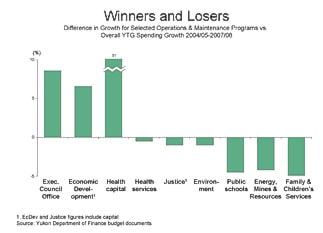‘Follow the money.”
That’s what Deep Throat told Bob Woodward to do if he wanted to unravel President Nixon’s shenanigans during the Watergate scandal.
It’s always been a well-used approach in forensic accountancy, counterintelligence and even parenting teenagers.
But it’s most useful in politics.
Politicians describe nearly everything as a “priority.”
I was once excited to hear Paul Martin describing one of my pet issues as a priority. Of course it turned out that he had dozens of other priorities too.
So how can citizens tell if politicians really think an issue is important?
One way is to see if they fund it.
Governments have elaborate processes for developing policy, assessing proposals and allocating money.
In the end, where a government puts its chequebook is a pretty good indicator of where its priorities really are.
So let’s apply this simple principle to the recent Yukon government mini-budget, known to aficionados as Supplementary Estimates No. 1 2007-08 (October 2007).
We’ll look at the three years from 2004/05 to 2007/08 to smooth out one-time events.
Over that period, Yukon government operating and capital spending grew, on average, an impressive 9.4 per cent or $70-90 million per year.
We’ll use a basic test: did a “priority” get more or less than its “fair share” when ministers divided up the extra money each year?
And to make sure this column doesn’t get as tedious as a real management board meeting, we’ll only look at a few high-profile programs.
Winners: (budgets that grew faster than total Yukon government spending).
Executive Council Office: with operations spending growing 18 per cent per year thanks to things like land claims implementation spending.
Economic Development: 16 per cent annual growth in operations and capital, with operations spending up 12 per cent per year and significant money in funds such as the Community Development Fund and the Strategic Industries Development Fund.
Health: capital spending 60 per cent annual growth, thanks in part to federal health capital funding.
About the same: (operational budgets that roughly kept pace)
Health Services: nine per cent
Justice: eight per cent.
Environment: eight per cent.
Losers: (budgets that grew slower than total Yukon government spending)
Public schools: five per cent spending growth in operational spending per year, with the capital budget for new equipment, roof repairs and so on in this fiscal year expected to be 31 per cent lower than it was in 2004/05. It was higher in the years in between thanks to the Tantalus School construction project.
Energy, Mines and Resources: Five per cent spending growth per year, which indicates some strong management in that department since this coincided with a boom in mining and exploration activity.
Family and Children’s Services: Five per cent spending growth per year.
These results are just a starting point.
To use a few typical budgetary clichés, the situation on the ground is more nuanced than these high level views, and there may be sound operational reasons why the public school funding envelope should be degrowthed on a going forward basis.
On the one hand, the number of school children has been falling at most schools.
On the other hand, many schools seem have lots of students with poor learning outcomes and the Yukon does not compare favourably with Canadian averages on things like dropout rates and test achievements.
On the third hand, more money may or may not be the answer to these challenges.
It’s complicated.
But somehow the Yukon government decided to grow public school funding more slowly than most other departments.
So next time you run into a cabinet minister, be sure to ask about it.
So what will the government do next?
Despite growing expenditures faster than inflation, population growth and gross domestic product in recent years, the government still has a significant cash surplus, thanks to the economic boom and growing federal transfers.
It expects to have $99.6 million in cash on hand at the end of March 2008.
So ministers have the capacity to do some interesting things if they want to.
Some prudence is necessary of course.
For one thing, the government announced recently in the Public Accounts, Part Two Consolidated Financial Statements, Page 50, Section 27, Subsection © that it had invested $36 million of Yukoners’ money in two unnamed trusts affected by the recent “credit crunch.”
These trusts were unable to pay back the Yukon’s money on time a few weeks ago.
Presumably the government was yield-surfing in obscure asset backed commercial paper to earn higher interest rates than it could get with treasury bills or investment vehicles backed by the big five banks.
“It is still too early to determine the final outcome of the situation and the resulting financial impact to the government, if any,” noted the department of Finance.
Bay Street wizards are currently meeting to figure out what to do, and how much of a haircut Yukoners will take.
It could range from none, to a minor trim to a full Brazilian body wax.
But in any case, the government still has more than $60 million in cash on hand. Plus whatever they get back from those two trusts.
It will be fun to see who this year’s winners and losers will be.
Keith Halliday is a Yukon economist and children’s author.
